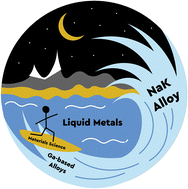NaK alloy: underrated liquid metal
Abstract
Liquid metals are poised to become a vital material for numerous challenges in science. The unique combination of metallicity and fluidity allows these materials to be used in inorganic synthesis, catalysis, electronics, photonics, robotics, and medicine. Among liquid metals, the sodium–potassium liquid alloy (NaK) is severely underutilised, mainly because of its high reactivity. However, in some cases, it is an essential tool for the synthesis and functionalisation of materials, and, in other cases, it can be reduced by stabilising NaK in inert matrices. Despite its disadvantages, NaK is characterised by some exceptional physical and chemical properties and combines not only metallicity and fluidity, but also the strongest reduction potential, which makes it useful for many scientific and industrial applications. This review aims to present and summarise the physical and chemical properties of NaK as well as current and potential applications of this alloy. We attempt to answer what new effects can be found on NaK systems and how the landscape of their application can be changed in case of its widespread introduction. This review shows why this is becoming possible today. We strongly believe that the study and use of this advanced material has the potential to transform entire branches of science and industry, such as materials synthesis, biomedicine, microelectronics, catalysis, and sustainable chemistry.



 Please wait while we load your content...
Please wait while we load your content...